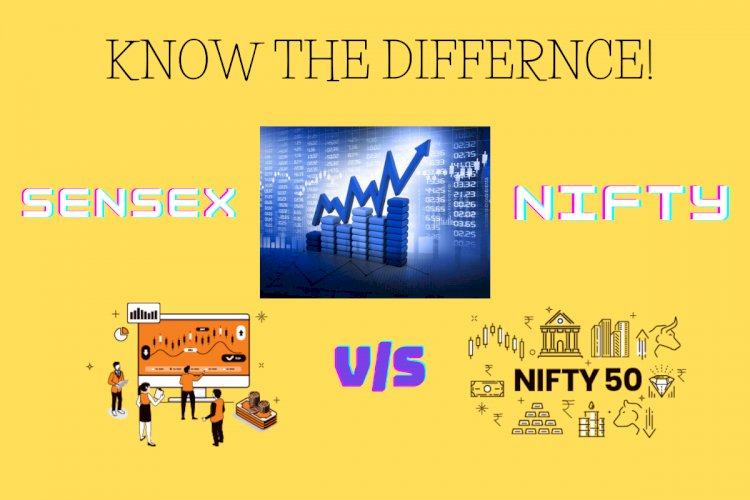Difference Between Sensex and Nifty
Nifty consists of 50 selected stocks from the top 50 companies , which are used to determine the index where as Sensex consists of 30 selected stocks. One of the most critical points of difference between Sensex and Nifty is the number of stocks each index comprises.

When we need to guess the general market direction, we look at the market index. All the top stock exchanges worldwide have indices that depict market behaviour or investor sentiment.
In India, Nifty and Sensex are important stock indices, which determine or depict the strength of the stock market. For equities, Sensex is the oldest market index, and includes shares from the top 30 companies listed on the Bombay Stock Exchange (BSE), representing roughly around 45 percent of the index’s free-float market capitalization. Nifty on the other hand includes shares from the top 50 companies listed on the National Stock Exchange (NSE), representing roughly around 62 percent of the index’s free-float market capitalization.
Investors also benefit as they get an opportunity to invest in these companies that can result in wealth creation. Government too can raise funds for developmental projects through the exchange.
What is Index?
An index is made up of securities that are chosen based on market capitalisation or other criteria. Any change in the price of the underlying securities affects the value of the index. Since the index represents the entire market, any change in the value of the index affects the value of companies that are not listed and other financial products, including commodities.
Indexes are also created to measure economic indicators like inflation and interest rates. They act as a benchmark to gauge portfolio returns. Investors can compare their investment portfolio returns against the benchmark returns and make changes to their portfolio if needed.
The companies that feature in the index usually span across multiple sectors and industries in the economy. In the context of the stock market, an index is the statistical indicator of change in the performance of securities that can replicate a specific market area.
Furthermore, the companies in a stock index are generally well-established and represent their industry or sector. Since an index has companies from almost all the major sectors and industries, it is widely regarded as one of the best indicators of the performance of an economy. In addition to being able to invest in companies, you can also invest in stock indexes through various mutual fund schemes. However, you would again be required to possess one of the best demat accounts to get started.
Investors use said index to contrast performance across a specific period. Broad-market indexes capture the performance of multiple industries; whereas there are indexes that only account for a specific industry.
There are two large cap indices in the Indian stock market, which are the S&P BSE Sensex, and the S&P CNX Nifty. Both Nifty and Sensex are broad-market indices that function on free-float market capitalisation methodology. Thus, the reason these indexes are considered as economic barometers.
What is Sensex?
Sensex is the portmanteau between sensitive and index and is the market index of the Bombay Stock Exchange (BSE). It is also known as S&P BSE Sensex. It is an index on the Bombay Stock Exchange or BSE. Sensex comprises 30 companies, and these are chosen based on the liquidity, market capitalisation, revenue, and diversification of the company. Also, for a company to be on Sensex, has to be listed on BSE.
It is one of India’s oldest indices, and people consider it a measure of market performance and reflection of the Indian economy. It is used as a benchmark to gauge growth and development in the Indian economy and industry and understand the stock market trend.
The value of the index depends on the price movement of the underlying securities. An increase in the value of Sensex is due to an increase in the price of most of the securities. While a decrease in the value of the index is due to the fall in the price of most of the underlying securities.
The Sensex was first published in the year 1986 (i.e 34 years ago).
Companies raise capital by IPO (Initial Public Offering) and after IPO gets over, these companies get listed on the stock exchanges such as BSE, NSE. This provides a greater opportunity for the public to buy these shares for the attainment of their short or long term goals.
Another critical point in illustrating Sensex vs Nifty is that the former constitutes of the top 30 companies trading in BSE as compared to Nifty that comprises the top 50 companies.
Furthermore, Sensex is the older of these two indexes. The Bombay Stock Exchange introduced it in 1986 when this index followed a weighted market capitalisation method. Later in 2003, Sensex migrated to the free-float market capitalisation method. The base value for calculating Sensex is 100 – another critical difference between Sensex and Nifty – and 1978-79 is the base year considered for its calculation.
The proportion of all the shares issued by companies that are readily available for trading to the general public in the market is known as free-float market capitalization. In the free-float market capitalization method, the market value of all the 30 selected stocks, relative to a base period is reflected by the index. Sensex is calculated by first determining the market capitalization of each of the 30 companies, and then multiplying it to the free-float factor, which provides the free-float market capitalization. It is then divided by the Index Divisor.
What is Nifty?
The National Stock Exchange Fifty (Nifty) is the stock market index of the National Stock Exchange (NSE). Also known as NIFTY 50 and CNX Nifty, it comprises 50 stocks that are actively traded on NSE, and is owned and managed by India Index Services and Products Ltd. (IISL), a subsidiary of NSE. Furthermore, the base value of the index is 1000, and it is computed using the free-float market capitalization weighted method.
One of the most critical points of difference between Sensex and Nifty is the number of stocks each index comprises. Nifty 50 includes stocks from the top 50 of nearly 1600 companies actively traded in NSE across 24 sectors.
These 50 stocks account for nearly 65% of the total free-float market capitalisation of the index. Thence, Nifty reflects the performance of those top 50 stocks.
Nifty 50 is primarily used for benchmarking index funds, index-based derivatives, and fund portfolios. Index Services and Products Limited (IISL), a subsidiary of NSE, owns and manages Nifty. Furthermore, the base value of Nifty 50 is 1000 and 1995 is considered as its base year for calculation of the index per float-adjusted market capitalisation methodology.
Similar to Sensex, the market capitalization is first calculated by multiplying equity with market price. To determine the free-float capitalization, the equity capital is multiplied by the price, and it is once again multiplied with the IWF (Investible Weight Factor). Nifty is then calculated on a daily basis, by dividing the current market value by the base market capital, and is multiplied by the base index value of 1000.
Here’s the basic Difference Between Sensex And Nifty :-
|
Basis of distinction |
Sensex |
Nifty |
|
Full Form |
Sensitive and Index |
National and Fifty |
|
Benchmark Index of |
BSE |
NSE |
|
Year of Establishment |
1875 |
1992 |
|
Aliases |
S&P BSE Sensex |
Nifty 50 and S&P CNX Fifty |
|
Owned By |
Owned by Bombay Stock Exchange (BSE). |
Owned and managed by an NSE subsidiary, Index and Services and Products Limited (IISL). |
|
Launched Date |
1st January 1986 |
21st April 1996 |
|
Vision |
Emerge as the premier Indian Stock Exchange with best in class global practice in technology, products innovation and customer services. |
Continue to be a leader, establish global presence, facilitate the financial well being of people. |
|
Introduction of Electronic System |
1995 |
1992 |
|
Number of constituents |
Sensex comprises the top 30 companies actively traded in BSE. |
Nifty 50 constitutes of the top 50 companies that are actively traded in NSE. |
|
Number of sectors covered |
Sensex covers 13 sectors. |
Nifty is a broader market index that covers 24 sectors. |
|
Base Period |
1978-79 |
November 3rd 1995 |
|
Base Number |
Its base number is 100. |
Its base number is 1000. |
|
Base Capital |
N/A |
Rs.2.06 trillion |
|
Foreign Exchanges |
It trades on EUREX and stock exchanges of BRCS nations. |
Nifty 50 trades on the Singapore Stock Exchange (SGX) and Chicago Mercantile Exchange (SME). |
|
Volume & Liquidity |
Low |
High |
|
Website |
||
|
Instruments Traded |
Equity, Mutual Funds, Debt Instruments, Currencies, Derivatives. |
Equity, Debt, Equity and Currency Derivatives. |
|
Market Capitalization Factor |
Free Float Factor |
Investible Weight Factor (IWF) |
|
Index Calculation Formula
|
|
|

 Arindam Deshmukh
Arindam Deshmukh 





















